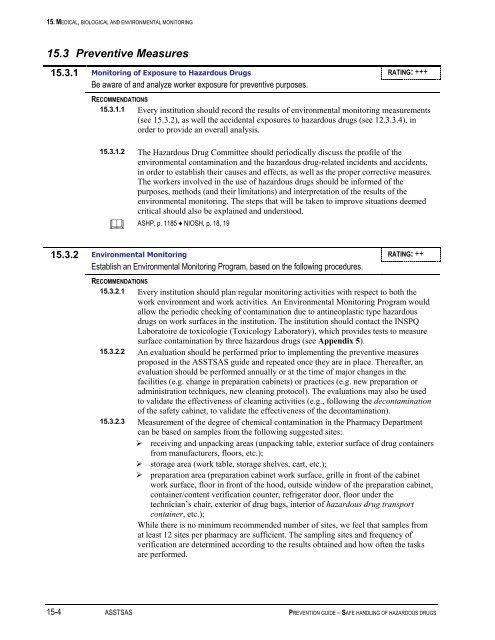Prevention Guide - Safe Handling of Hazardous Drugs - Irsst
Prevention Guide - Safe Handling of Hazardous Drugs - Irsst
Prevention Guide - Safe Handling of Hazardous Drugs - Irsst
Create successful ePaper yourself
Turn your PDF publications into a flip-book with our unique Google optimized e-Paper software.
15. MEDICAL, BIOLOGICAL AND ENVIRONMENTAL MONITORING<br />
15.3 Preventive Measures<br />
15.3.1 Monitoring <strong>of</strong> Exposure to <strong>Hazardous</strong> <strong>Drugs</strong> RATING: +++<br />
Be aware <strong>of</strong> and analyze worker exposure for preventive purposes.<br />
RECOMMENDATIONS<br />
15.3.1.1 Every institution should record the results <strong>of</strong> environmental monitoring measurements<br />
(see 15.3.2), as well the accidental exposures to hazardous drugs (see 12.3.3.4), in<br />
order to provide an overall analysis.<br />
15.3.1.2 The <strong>Hazardous</strong> Drug Committee should periodically discuss the pr<strong>of</strong>ile <strong>of</strong> the<br />
environmental contamination and the hazardous drug-related incidents and accidents,<br />
in order to establish their causes and effects, as well as the proper corrective measures.<br />
The workers involved in the use <strong>of</strong> hazardous drugs should be informed <strong>of</strong> the<br />
purposes, methods (and their limitations) and interpretation <strong>of</strong> the results <strong>of</strong> the<br />
environmental monitoring. The steps that will be taken to improve situations deemed<br />
critical should also be explained and understood.<br />
<br />
ASHP, p. 1185 ♦ NIOSH, p. 18, 19<br />
15.3.2 Environmental Monitoring RATING: ++<br />
Establish an Environmental Monitoring Program, based on the following procedures.<br />
RECOMMENDATIONS<br />
15.3.2.1 Every institution should plan regular monitoring activities with respect to both the<br />
work environment and work activities. An Environmental Monitoring Program would<br />
allow the periodic checking <strong>of</strong> contamination due to antineoplastic type hazardous<br />
drugs on work surfaces in the institution. The institution should contact the INSPQ<br />
Laboratoire de toxicologie (Toxicology Laboratory), which provides tests to measure<br />
surface contamination by three hazardous drugs (see Appendix 5).<br />
15.3.2.2 An evaluation should be performed prior to implementing the preventive measures<br />
proposed in the ASSTSAS guide and repeated once they are in place. Thereafter, an<br />
evaluation should be performed annually or at the time <strong>of</strong> major changes in the<br />
facilities (e.g. change in preparation cabinets) or practices (e.g. new preparation or<br />
administration techniques, new cleaning protocol). The evaluations may also be used<br />
to validate the effectiveness <strong>of</strong> cleaning activities (e.g., following the decontamination<br />
<strong>of</strong> the safety cabinet, to validate the effectiveness <strong>of</strong> the decontamination).<br />
15.3.2.3 Measurement <strong>of</strong> the degree <strong>of</strong> chemical contamination in the Pharmacy Department<br />
can be based on samples from the following suggested sites:<br />
‣ receiving and unpacking areas (unpacking table, exterior surface <strong>of</strong> drug containers<br />
from manufacturers, floors, etc.);<br />
‣ storage area (work table, storage shelves, cart, etc.);<br />
‣ preparation area (preparation cabinet work surface, grille in front <strong>of</strong> the cabinet<br />
work surface, floor in front <strong>of</strong> the hood, outside window <strong>of</strong> the preparation cabinet,<br />
container/content verification counter, refrigerator door, floor under the<br />
technician’s chair, exterior <strong>of</strong> drug bags, interior <strong>of</strong> hazardous drug transport<br />
container, etc.);<br />
While there is no minimum recommended number <strong>of</strong> sites, we feel that samples from<br />
at least 12 sites per pharmacy are sufficient. The sampling sites and frequency <strong>of</strong><br />
verification are determined according to the results obtained and how <strong>of</strong>ten the tasks<br />
are performed.<br />
15-4 ASSTSAS PREVENTION GUIDE – SAFE HANDLING OF HAZARDOUS DRUGS

















